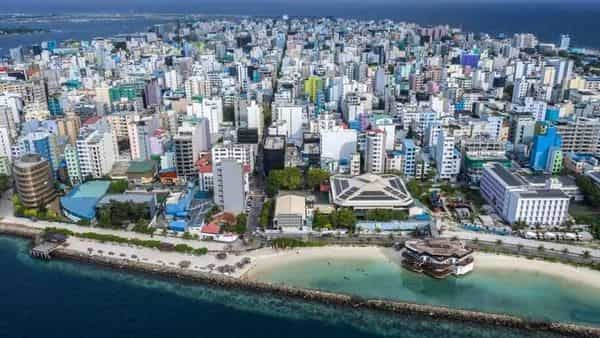The sea-bridge is part of the $1.4 billion aid India has promised for infrastructure projects in the Maldives. It seeks to connect four islands: the capital city of Malé, the residential island Villingili, the industrial and waste-processing island Thilafushi, and Gulhifalhu. In Gulhifalhu, the Maldivian government wants to reclaim 30 hectares of a lagoon to construct 6,000 housing units and 192 hectares to develop an international port. The idea is to kick-start an economy hit by covid-19 and decongest Malé, among the most expensive places to live in South Asia today. The port, too, will be funded by India.
But not everyone is enthused. Environmentalists in the Maldives, keen on a rethink on the approach to development, say the India-funded projects will damage marine habitats and lead to large-scale sedimentation in the coral reefs. One goes as far as to describe the land reclamation at Gulhifalhu as “ecocide” in a nation threatened by sea-level rise due to global warming. They would, in fact, like the Indian government to set environmental standards for projects funded by it.
The Indian investment, along with rumours of additional deployment of military personnel, has also prompted the opposition parties to accuse the government of “selling off national assets” to India. They have carried out several protests over the past few weeks, defying norms of physical distancing.
But the Maldives government has persevered, with initial work beginning on the port project. Mohamed Aslam, minister of national planning, housing and infrastructure, acknowledged the need to prevent environmental damage but said in June that the project was important to the national economy.
The life of an average Maldivian is seldom close to that advertised in its tourist brochures. Nearly a third of the population lives in Malé, a 6 sq. km island. Living space comes at a premium: A one-bedroom apartment can cost up to $1,000 a month in rent. Yet jobs, education and healthcare facilities are clustered in Malé, forcing youth to migrate to the capital. Often, they live in cramped apartments, sharing a room with several others.
“All these issues burst at its seams during the pandemic,” says Sara Naseem, research and communications officer at the Malé-based NGO Transparency Maldives. “The most striking part for me was when the police held a press conference recently to announce the penalties it had collected from people for stepping out during the lockdown. Some were fined up to 10 times. A lot of them were the elderly who had nowhere else to go.”
The 6,000 residential units planned at Gulhifalhu are meant to solve the housing crisis. But this goes against the government’s plans to decentralize development, maintains Naseem. “When this government was voted in, it said that jobs and services will be created in islands across the country and everyone would enjoy the benefits of development. Creating projects in and around Malé would prompt more people to move here.”
Concerns about environmental damage run deep. An environmental impact assessment (EIA) of the Gulhifalhu port project by the Maldives-based firm CDA Consulting found that the project can cause “loss and/or degradation of coral reef ecosystems and temporary degradation of marine water quality” in the construction stage. These, the report said, could be addressed through mitigation measures but had “substantial positive and negative impacts”. No EIA on the sea-bridge or the housing plan has been undertaken so far.
Environmentalists are not convinced. Shaziya Ali, part of the climate governance integrity program at Transparency Maldives, points out that only seven people’s comments were included in the EIA’s public consultation. “Besides,” she adds, “the Maldives Environment Protection Agency (EPA) is supposed to be an independent body but it is essentially an arm of the environment ministry.”
Mint reached out to the EPA for a comment but did not get a response.
Mohamed Shareef, vice-president of the main opposition Progressive Party of Maldives (PPM), says his government too had planned to construct a port and a bridge. “Only, the location we had chosen for reclamation was in shallow waters,” he says. “Here, the area they intend to reclaim is up to 30m deep. The sheer volume of sand you will use to dredge it will have a serious impact on virgin lagoons on the capital atolls.”
There is, of course, a geopolitical aspect to India’s investments in the Maldives. Sathiya Moorthy, a political analyst at the Observer Research Foundation, Delhi, says the bridge is India’s way of countering China’s overtures in the Indian Ocean. “It is to make sure our neighbours don’t have to depend on others for development as much as we can afford.” Doing so is in India’s strategic interests, despite the crumbling economy at home.
“India is in a quad (Quadrilateral Security Dialogue, an informal strategic forum) with the US, Japan and Australia. So this is also a military alliance taking shape,” he adds.
India-Maldives relations, which frayed under former president Abdulla Yameen, have seen an uptick under his successor, Ibrahim Mohamed Solih. It was during his maiden visit to the Maldives in 2018 that Prime Minister Narendra Modi announced the $1.4 billion package. The Maldives, in turn, has supported India at international fora. In May, it even defended India at a meeting of Organization of Islamic Cooperation countries against accusations of fomenting Islamophobia within.
Environmentalists understand the context but fear the result. The EIA report on the port project was released in April. The reclamation at Gulhifalhu has begun. Over the summer, residents of the neighbouring Vilimale island reported high levels of sedimentation in the water. Local NGO Save The Beach Maldives alleged mitigation measures, such as silt nets to reduce sedimentation, were not in place. The EPA, however, maintained sediment levels were below the threshold limit set by it.
On World Environment Day on 5 June, Save Maldives, a citizens’ collective on environmental issues, wrote an open letter to Parliament to “stop the Gulhifalhu ecocide” and “rethink unsustainable, debt-funded development projects”. “The project will irreversibly destroy the Gulhifalhu reef ecosystem, directly impacting an area of over 13 sq. km,” the letter said. “The expected environmental loss and damage are already emerging, as sedimentation from dredging threatens the surrounding area, including the Vilimale house reef and dive sites nearby, impacting the livelihoods of divers, fisherfolk, resorts and other local businesses.”
The letter came only days after Ahmed Usham, member of Parliament from the Vilimale island, raised similar concerns about the project in Parliament. It was widely covered in the local media. On 7 June, Nasheed acknowledged the concerns, tweeting, “The Gulhi Falhu work is important & brings many benefits. But it can’t be allowed to destroy local reefs.”
Adam Isham, an activist from the collective, says the government has done little since. In February, he points out, a unanimous vote in Parliament saw the Maldives agreeing on a resolution declaring a climate emergency, expressing concern at rising greenhouse gas (GHG) emissions and the impact these will have on low-lying island nations like theirs.
“Yet all we have seen since is more concrete,” says Isham. “There seems to be no political will to change how we are developing our infrastructure and adapting to climate change.”
The proposed infrastructure projects, he says, will cause “irreparable damage” to the Maldives’ fragile ecosystem. Moreover, hundreds of surfers, snorkelers and divers in the capital will no longer be able to enjoy their environment.
“Take the China-Maldives Friendship Bridge,” he says. “The government had ignored environmental concerns then. After the bridge was opened, a lot of debris and waste was left in the lagoon, destroying corals. It also threatened the safety of the people using the area and caused a decline in fisheries.” The upcoming infrastructure projects, he adds, will likely have a similar impact.
“I really think the Indian government should reconsider this,” says Isham. “When there’s foreign aid, a lot of donors have strict environmental and social standards. They want to make sure the projects don’t impact the environment negatively. This project will definitely do that. It’s a given.”
Source URL: Bing News :







